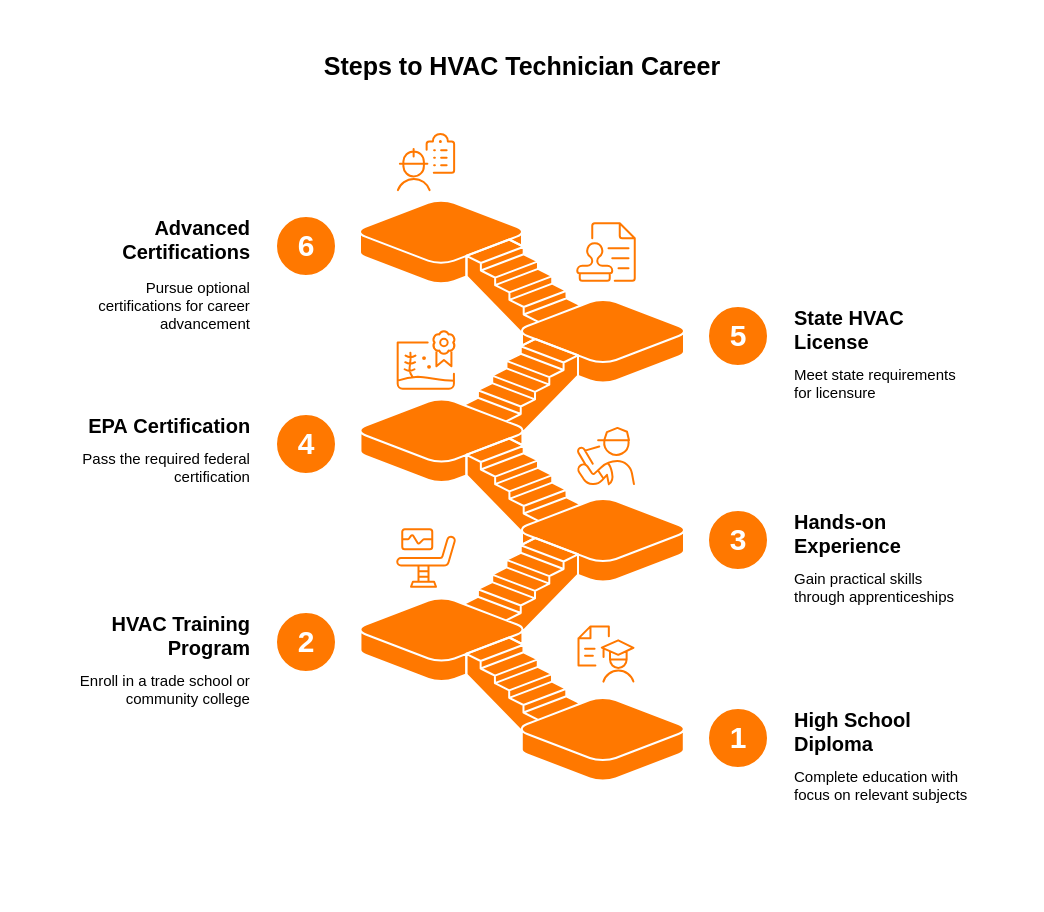How to Become an HVAC Technician
- What HVAC Technicians Do
- Key Skills for HVAC Success
- Common Work Environments
- How to Become an HVAC Technician (5 Steps)
- Licensing and Certification Options
- State HVAC Requirements
- Education and Training Paths
- Career Growth and Specializations
- Training Duration and Cost Overview
- Pros and Considerations
- Start Your HVAC Training
- Quick Facts: HVAC Training, Licensing, and Outlook
HVAC technicians keep comfort running.
From homes and schools to hospitals and data centers, these skilled professionals install, maintain, and repair systems that control temperature and air quality.
If you enjoy hands-on, technical work and solving mechanical problems, HVAC is a field that rewards focus, skill, and ongoing learning.
What HVAC Technicians Do
HVAC stands for Heating, Ventilation, and Air Conditioning. Technicians service systems that manage indoor comfort and air quality.
Typical Responsibilities
- Install and maintain heating and cooling systems
- Diagnose electrical, refrigerant, or airflow issues
- Replace or repair components and controls
- Perform safety and efficiency checks
- Comply with building codes and EPA regulations
HVAC work blends electrical, mechanical, and environmental knowledge into one essential trade.
Key Skills for HVAC Success
- Mechanical and electrical aptitude
- Problem-solving and diagnostic skills
- Understanding of pressure, airflow, and thermodynamics
- Strong focus on safety and compliance
- Clear communication and customer service
Common Work Environments
HVAC technicians are employed in:
- Residential and commercial construction
- Maintenance and facilities operations
- Industrial or refrigeration systems
- Energy management and green technology sectors
How to Become an HVAC Technician (5 Steps)
Becoming an HVAC technician typically takes 6 months to 2 years, depending on the training program and your state’s requirements.
1. Earn a High School Diploma or GED
Courses in math, physics, and shop build useful foundations for mechanical and electrical concepts.
2. Complete HVAC Training
Enroll in an accredited trade school or community college offering HVAC coursework. Programs combine classroom instruction with hands-on lab experience in heating, cooling, and refrigeration systems.
3. Gain Field Experience
Many technicians join apprenticeships or entry-level assistant roles to apply what they’ve learned on real job sites under supervision.
4. Earn EPA Section 608 Certification
This federal credential is required to handle refrigerants safely. Testing covers core environmental and equipment topics.
5. Obtain State Licensing (if applicable)
Several states require HVAC licenses, which may involve an exam, verified work hours, and proof of insurance. Always confirm your local regulations.
Licensing and Certification Options
Most technicians start with the EPA Section 608 certification, then add credentials such as:
- NATE Certification – Nationally recognized technical proficiency
- HVAC Excellence – Validates advanced system knowledge
- RSES Certificates – Focused on refrigeration service
- Manufacturer-specific training – For specialized systems
State HVAC Requirements
Each state manages its own licensing process. Some require additional certifications or continuing education for renewal.
| State | Guide |
|---|---|
| Texas | HVAC in Texas |
| Florida | HVAC in Florida |
| California | HVAC in California |
Education and Training Paths
| Pathway | Typical Duration | Outcome |
|---|---|---|
| Certificate or Diploma | 6–12 months | Entry-level knowledge |
| Associate Degree | 2 years | Broader technical background |
| Apprenticeship | 3–4 years | Paid on-the-job learning |
| Continuing Education | Ongoing | Certification renewals and new technologies |
Career Growth and Specializations
Experienced HVAC technicians may advance into:
- System Installer or Project Foreman
- Commercial Refrigeration Specialist
- Controls or Energy Management Technician
- Contractor or Small Business Owner
Continuous learning keeps HVAC professionals adaptable as systems become smarter and more efficient.
Training Duration and Cost Overview
- Typical Length: 6 months – 2 years depending on program
- Format: Classroom + hands-on or apprenticeship
- Requirements: EPA 608 certification; state license where required
Program costs and schedules vary. Check details directly with each provider or licensing board.
Pros and Considerations
Start Your HVAC Training
If you like solving mechanical problems and keeping systems running, HVAC technology offers a practical way to build a stable, hands-on career.
Explore accredited training or apprenticeship options in your area.
🌡️ Find HVAC Programs Near You
Quick Facts: HVAC Training, Licensing, and Outlook

Hvac Salary by State

Meet the author: Brad Fishbein is a Florida Licensed Mold Assessor and council-certified Microbial Investigator. He’s the founder of TradeCareerPath.com and has completed over 5,000 mold inspections since 2009. Brad now helps homeowners and tradespeople make smart decisions about mold, licensing, and skilled career paths.
Notice an update we should make?
We strive for accuracy. Contact us here if you see incorrect or outdated info on this page.